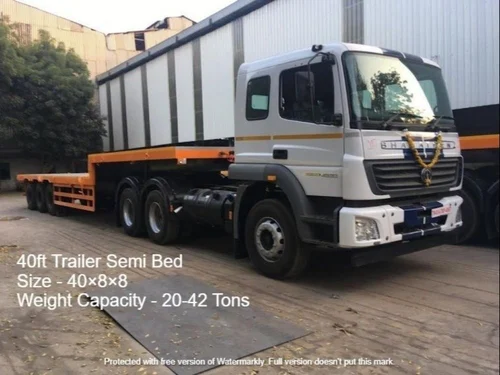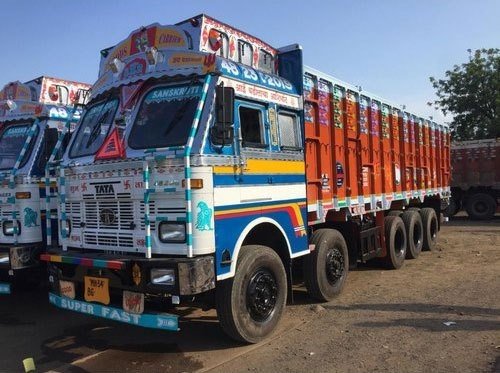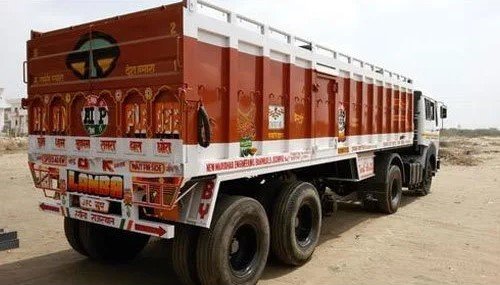EXPLORE THE SERVICES OF BEST HIGHWAY ROADWAYS
TOP VALUES
FOR YOU
Easy Booking Services
Different types of picking services
On time delivery
easy to track your goods
types of truck we have

35ft platform.
Dimensions: A 35-foot platform is a trailer or platform that measures approximately 35 feet (10.67 meters) in length. The width can vary but is typically around 8.5 feet (2.59 meters).
Design: Flatbed trailers or platforms are characterized by their open, flat surface without any sidewalls or roof. This design allows for easy loading and unloading of oversized or irregularly shaped cargo.
Payload Capacity: The payload capacity of a 35-foot platform depends on various factors such as the trailer’s construction, axle configuration, and the weight distribution of the cargo. It’s designed to carry a wide range of goods, including machinery, equipment, construction materials, and oversized loads.
Usage: Flatbed trailers are commonly used in industries such as construction, manufacturing, and transportation, where there’s a need to transport large, heavy, or irregularly shaped items that may not fit inside a standard enclosed trailer or container.
Loading and Securing: Cargo on a flatbed trailer is typically secured using straps, chains, or other tie-down methods to prevent shifting during transit. The absence of walls or a roof allows for flexibility in loading and securing different types of cargo.
Transportation: Flatbed trailers are often used for both short-haul and long-haul transportation. They can be pulled by semi-trucks or other heavy-duty vehicles equipped with a fifth wheel hitch.
Regulations: Flatbed trailers are subject to transportation regulations regarding weight limits, securing cargo, and vehicle dimensions. Compliance with these regulations ensures safety and legal compliance during transport.

full body 30 ton truck.
Chassis: The chassis forms the foundation of the truck, supporting the body and all attached components. It needs to be robust to handle the weight and stress of heavy loads.
Engine: A powerful engine is essential for propelling such a heavy vehicle. It would likely be a large-displacement diesel engine optimized for torque, providing the necessary pulling power.
Transmission: Heavy-duty trucks typically have transmissions with multiple gears to optimize performance across different driving conditions, including hauling heavy loads uphill or on rough terrain.
Cab: The cab of the truck houses the driver and possibly a passenger. It’s equipped with all necessary controls, instrumentation, and amenities for comfortable and safe operation.
Cargo Body/Trailer: Depending on the specific configuration, the truck may have either a fixed cargo body or be designed to haul trailers. The cargo body or trailer would be designed to accommodate the payload capacity of around 30 tons.
Suspension: A robust suspension system is crucial for supporting the weight of the truck and its payload while providing a relatively smooth ride.
Braking System: Given the weight of the vehicle, it would require a powerful braking system, possibly with features like anti-lock brakes (ABS) and electronic brakeforce distribution (EBD) for optimal braking performance.
Safety Features: Modern trucks come equipped with various safety features such as airbags, stability control systems, collision avoidance systems, and advanced driver assistance systems (ADAS) to enhance safety for both the driver and other road users.
Fuel Tanks: With the heavy fuel consumption of such large engines, the truck would likely have sizable fuel tanks to ensure sufficient range between refueling stops.
Axles and Drivetrain: The truck would have multiple axles to distribute the weight evenly and provide traction. It may also feature differential locks or other advanced drivetrain technologies to improve off-road capability.

full body 35 ton truck.
Chassis: The truck is built on a robust chassis frame, engineered to withstand the stresses of heavy loads and rough terrain.
Engine: Equipped with a powerful diesel engine, optimized for torque and hauling capacity, enabling it to efficiently propel the truck and its payload.
Transmission: Typically equipped with a heavy-duty transmission system featuring multiple gears to optimize performance under varying load and road conditions.
Cab: The cab offers a comfortable and ergonomic environment for the driver, equipped with modern amenities and controls for long-haul drives.
Cargo Body/Trailer: Designed to accommodate payloads of up to 35 tons, the truck may feature either a fixed cargo body or be capable of hauling trailers to transport goods.
Suspension: A sturdy suspension system is essential for supporting the weight of the truck and its cargo while providing stability and ride comfort.
Braking System: Equipped with a robust braking system, including features like anti-lock brakes (ABS) and electronic brakeforce distribution (EBD) to ensure safe and reliable braking performance.
Safety Features: Modern trucks come with various safety features such as airbags, stability control systems, collision avoidance systems, and advanced driver assistance systems (ADAS) to enhance driver safety and mitigate the risk of accidents.
Fuel Efficiency: Despite its size and hauling capacity, the truck is designed to optimize fuel efficiency, helping to reduce operating costs over the long term.
Axles and Drivetrain: The truck features multiple axles and a robust drivetrain to distribute the weight evenly and provide traction, ensuring stability and control even when carrying heavy loads.

full body 40 ton truck.
Chassis: The truck is built on a robust chassis frame, engineered to withstand the immense weight and stresses associated with hauling up to 40 tons of cargo.
Engine: Equipped with a powerful diesel engine, specifically designed to deliver high torque and horsepower, allowing the truck to propel itself and its heavy load with ease.
Transmission: Typically fitted with a heavy-duty transmission system featuring multiple gears to optimize performance under various load and terrain conditions while maintaining fuel efficiency.
Cab: The cab offers a comfortable and ergonomic workspace for the driver, equipped with modern amenities, ergonomic seating, and advanced controls for long-haul journeys.
Cargo Body/Trailer: The truck may feature a fixed cargo body or be designed to haul trailers capable of accommodating payloads of up to 40 tons, depending on the specific application and configuration.
Suspension: A robust suspension system is crucial for supporting the weight of the truck and its cargo while providing stability, control, and a smooth ride over uneven terrain.
Braking System: Equipped with a powerful braking system, including features like anti-lock brakes (ABS), electronic stability control (ESC), and hydraulic brake assist, to ensure safe and reliable stopping even with heavy loads.
Safety Features: Modern trucks are equipped with a range of safety features, including airbags, collision avoidance systems, lane departure warning, and advanced driver assistance systems (ADAS), to enhance driver safety and mitigate the risk of accidents.
Fuel Efficiency: Despite its size and hauling capacity, the truck is designed to optimize fuel efficiency through aerodynamic enhancements, engine technologies, and advanced fuel management systems.
Axles and Drivetrain: The truck features multiple axles and a robust drivetrain to distribute the weight evenly and provide traction, ensuring stability and control even under challenging driving conditions.

container 32 ft.
Dimensions: A 32-foot container typically measures approximately 32 feet (9.75 meters) in length, 8 feet (2.44 meters) in width, and 8.5 feet (2.59 meters) in height.
Construction: These containers are usually made of steel and are designed to withstand the rigors of transportation, including stacking, loading, and unloading.
Capacity: The interior space of a 32-foot container can vary depending on its design and purpose, but it generally provides ample room for storing and transporting goods.
Usage: 32-foot containers are commonly used in intermodal transportation, where goods are transferred between different modes of transport (trucks, trains, ships) without the need to unload and reload the cargo. They are also used for storage purposes at warehouses, construction sites, and other locations.
Handling: These containers are typically equipped with standardized corner fittings, allowing them to be lifted and moved by cranes or forklifts. They can also be secured to trucks or railcars for transportation.
Types: 32-foot containers come in various types, including dry containers for general cargo, refrigerated containers for perishable goods, and specialized containers for specific types of cargo such as liquids or hazardous materials.
